-
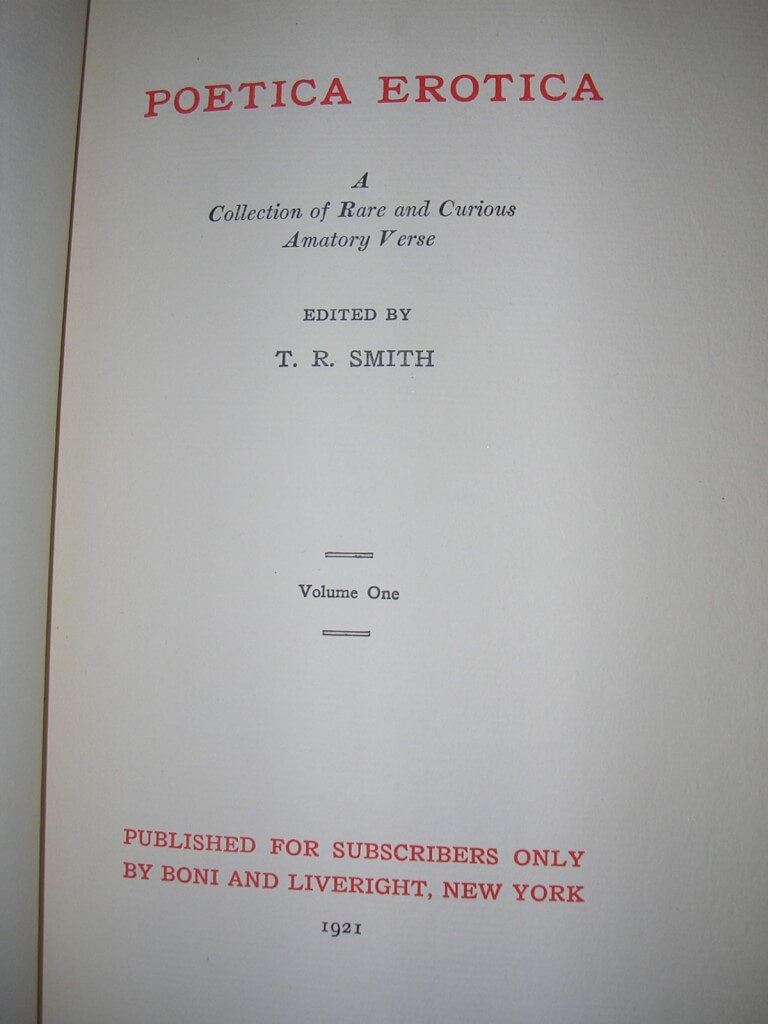
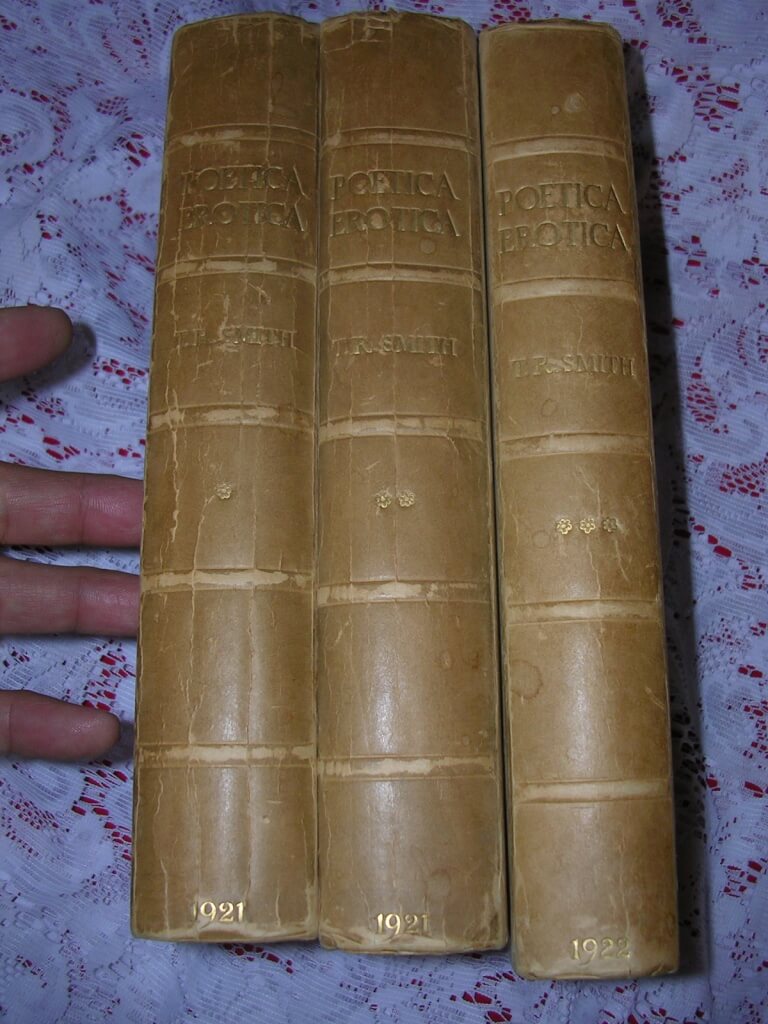 Poetica Erotica, T.R. Smith (editor) (Boni and Liveright, New York, 1921 (Vol. 3, 1922) [limited first edition, #523/1500]) 9 1/4" X 6 1/4", 3 vol. xxviii + 324, xvi + 328, xiv + 280, hardbound with green boards with cream vellum spines, deckle edges, corners bumped and worn, binding is tight, vol. 2 boards slightly loose. T. R. Smith writes "In these volumes Eros rules and Aphrodite guides the passionate motives....The poems contained in these volumes range from the earliest time to the present and the names of the most distinguished poets of yesterday and today will be found in the contents."
Poetica Erotica, T.R. Smith (editor) (Boni and Liveright, New York, 1921 (Vol. 3, 1922) [limited first edition, #523/1500]) 9 1/4" X 6 1/4", 3 vol. xxviii + 324, xvi + 328, xiv + 280, hardbound with green boards with cream vellum spines, deckle edges, corners bumped and worn, binding is tight, vol. 2 boards slightly loose. T. R. Smith writes "In these volumes Eros rules and Aphrodite guides the passionate motives....The poems contained in these volumes range from the earliest time to the present and the names of the most distinguished poets of yesterday and today will be found in the contents." -
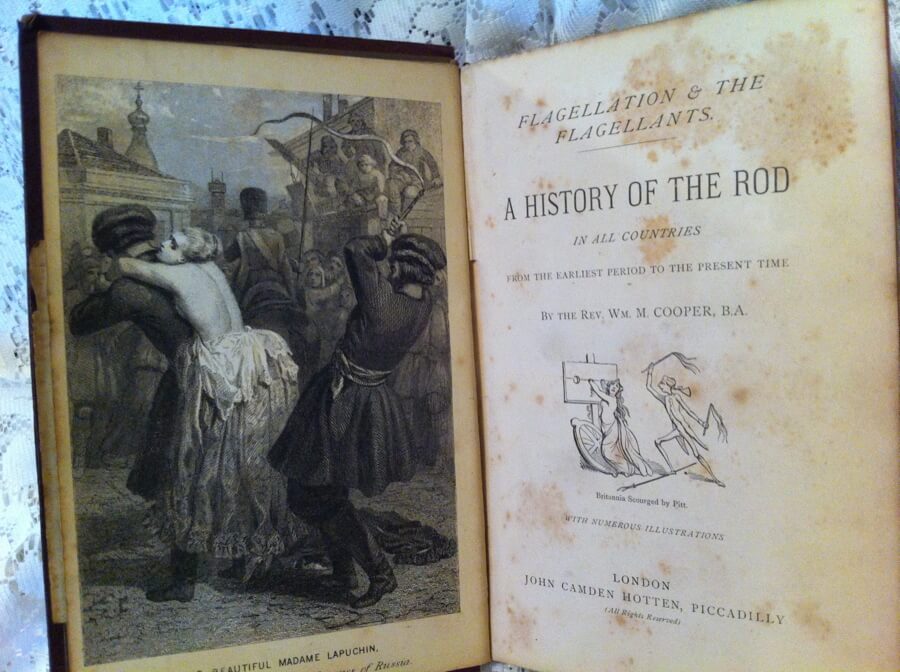
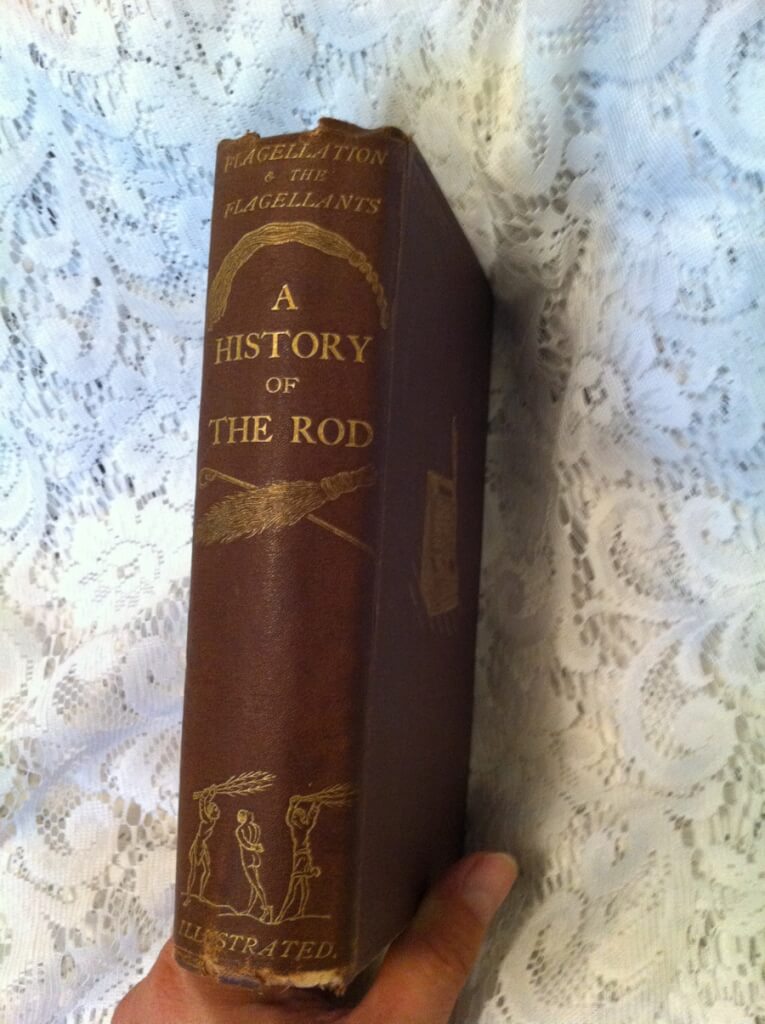 Flagellation & the Flagellants. a History of the Rod in All Countries, The Rev. Wm. M. Cooper, B.A. [James Glass Bertram] (John Camden Hotten, London, n.d. [1870, from ads at end of book]) 7 3/4" X 5 1/2", 544pp plus 32 pages of advertisements for "Very Important New Books", hardbound with red cloth, gilt lettering and decorations, spine worn at top and bottom and lower front, Binder's ticket on lower pastedown: "Bound by W. Bone and Son. 76 Fleet St. London E.C.", front pastdown has cute bookplate asking the book be returned to Robert Day, front end-paper has armorial bookplate of Robert Day. Good condition, corners bumped, top and bottom of spine worn, back boards loose but holding. Bertram was apprenticed to Tait's Edinburgh Magazine and became managing clerk, before joining a company of strolling players. He returned to Edinburgh and set up as a bookseller and newsagent. In 1855 he was appointed the editor of the North Briton and in 1872 of the Glasgow News, leaving to become a freelance journalist two years later. He published "flagellation" pornography under the names "Revd William Cooper" and "Margaret Anson". Illustrated throughout with a colored frontispiece. The bookplate is of Robert Day (1836_1914), an Irish antiquarian and photographer who collaborated with Franz Tieze in producing imitation Williamite, Jacobite and Irish Volunteer glassware. He was an important and well-travelled antiquarian collector. He was involved in his family's extensive saddlery business together with a sports shop well known to Cork anglers.
Flagellation & the Flagellants. a History of the Rod in All Countries, The Rev. Wm. M. Cooper, B.A. [James Glass Bertram] (John Camden Hotten, London, n.d. [1870, from ads at end of book]) 7 3/4" X 5 1/2", 544pp plus 32 pages of advertisements for "Very Important New Books", hardbound with red cloth, gilt lettering and decorations, spine worn at top and bottom and lower front, Binder's ticket on lower pastedown: "Bound by W. Bone and Son. 76 Fleet St. London E.C.", front pastdown has cute bookplate asking the book be returned to Robert Day, front end-paper has armorial bookplate of Robert Day. Good condition, corners bumped, top and bottom of spine worn, back boards loose but holding. Bertram was apprenticed to Tait's Edinburgh Magazine and became managing clerk, before joining a company of strolling players. He returned to Edinburgh and set up as a bookseller and newsagent. In 1855 he was appointed the editor of the North Briton and in 1872 of the Glasgow News, leaving to become a freelance journalist two years later. He published "flagellation" pornography under the names "Revd William Cooper" and "Margaret Anson". Illustrated throughout with a colored frontispiece. The bookplate is of Robert Day (1836_1914), an Irish antiquarian and photographer who collaborated with Franz Tieze in producing imitation Williamite, Jacobite and Irish Volunteer glassware. He was an important and well-travelled antiquarian collector. He was involved in his family's extensive saddlery business together with a sports shop well known to Cork anglers. -
Out of stock
 Emmanuelle, Bianca, and Venus in Furs, Emmanuelle Arsan, Leopold von Sacher-Masoch, Guido Crepax, introduction by Paolo Caneppelle and Günter Krenn [Evergreen/Benedikt Taschen Verlag GmbH, 2000, Germany, 1st edition thus] 8 x 10.5", 463pp, Hardcover w/DJ, red boards with white lettering, like-new condition. Published in 2000, and nolonger in print, designed by Lambert & Lambert, this edition has become rare and sought after. It was published with another volume “Justine and The Story of O”. This book has three of Crepax’s graphic novels. All three (like most of Crepax’s works) are very sexually graphic stories of sexual self-discovery under varying circumstances. Guido Crepas (1933-2003), better known by his nom de plume Guido Crepax, was an Italian comics artist. He is most famous for his character Valentina, created in 1965 and very representative of the spirit of the 1960s. The Valentina series of books and strips became noted for Crepax's sophisticated drawing, and for the psychedelic, dreamlike storylines, generally involving a strong dose of erotism. Marayat Rollet-Andriane formerly Marayat Krasaesin (1932-2005), known by the pen name Emmanuelle Arsan, was a French novelist of Thai origin, best known for the novel featuring the fictional character Emmanuelle, a woman who sets out on a voyage of sexual self-discovery under varying circumstances. It was later claimed that the real author of the book was her husband, Louis-Jacques Rollet-Andriane. The novel Emmanuelle was initially published and distributed clandestinely in France in 1959, without an author's name. Successive editions were ascribed to Emmanuelle Arsan, who was subsequently revealed to be Marayat Rollet-Andriane. Though the novel was sometimes hinted to be quasi-autobiographical, it was later revealed that the actual author was her husband Louis-Jacques Rollet-Andriane. Several more novels were published under the Emmanuelle Arsan pseudonym. Venus in Furs (German: Venus im Pelz) is a novella by Leopold Ritter von Sacher-Masoch (1836-1895), an Austrian writer and journalist. It is now his best known work and because of its themes the term masochism is derived from his name, coined by the Austrian psychiatrist, Krafft-Ebing. The novel was to be part of an epic series that Sacher-Masoch envisioned called Legacy of Cain. Venus in Furs was part of Love, the first volume of the series. It was published in 1870. The novel draws themes, like female dominance and sadomasochism, and character inspiration heavily from Sacher-Masoch's own life. Wanda von Dunajew, the novel's central female character, was modelled after his mistress Baroness Fanny Pistor. In December 1869 the two signed a contract making him her slave for a period of 6 months. In 1873, after the publication of Venus in Furs, Sacher-Masoch married Aurora von Rümelin who he pressured to continue the lifestyle he wrote about in his book. After 10 years they divorced. Rümelin, using the pseudonym of the books title character, "Wanda von Dunajew", wrote Meine Lebensbeichte (My Life Confession) published in 1906. It detailed Sacher-Masoch's private life and her relationship with him. During his lifetime, Sacher-Masoch was well known as a man of letters, a utopian thinker who espoused socialist and humanist ideals in his fiction and non-fiction. Most of his works remain untranslated into English. Until recently, his novel Venus in Furs was his only book commonly available in English.
Emmanuelle, Bianca, and Venus in Furs, Emmanuelle Arsan, Leopold von Sacher-Masoch, Guido Crepax, introduction by Paolo Caneppelle and Günter Krenn [Evergreen/Benedikt Taschen Verlag GmbH, 2000, Germany, 1st edition thus] 8 x 10.5", 463pp, Hardcover w/DJ, red boards with white lettering, like-new condition. Published in 2000, and nolonger in print, designed by Lambert & Lambert, this edition has become rare and sought after. It was published with another volume “Justine and The Story of O”. This book has three of Crepax’s graphic novels. All three (like most of Crepax’s works) are very sexually graphic stories of sexual self-discovery under varying circumstances. Guido Crepas (1933-2003), better known by his nom de plume Guido Crepax, was an Italian comics artist. He is most famous for his character Valentina, created in 1965 and very representative of the spirit of the 1960s. The Valentina series of books and strips became noted for Crepax's sophisticated drawing, and for the psychedelic, dreamlike storylines, generally involving a strong dose of erotism. Marayat Rollet-Andriane formerly Marayat Krasaesin (1932-2005), known by the pen name Emmanuelle Arsan, was a French novelist of Thai origin, best known for the novel featuring the fictional character Emmanuelle, a woman who sets out on a voyage of sexual self-discovery under varying circumstances. It was later claimed that the real author of the book was her husband, Louis-Jacques Rollet-Andriane. The novel Emmanuelle was initially published and distributed clandestinely in France in 1959, without an author's name. Successive editions were ascribed to Emmanuelle Arsan, who was subsequently revealed to be Marayat Rollet-Andriane. Though the novel was sometimes hinted to be quasi-autobiographical, it was later revealed that the actual author was her husband Louis-Jacques Rollet-Andriane. Several more novels were published under the Emmanuelle Arsan pseudonym. Venus in Furs (German: Venus im Pelz) is a novella by Leopold Ritter von Sacher-Masoch (1836-1895), an Austrian writer and journalist. It is now his best known work and because of its themes the term masochism is derived from his name, coined by the Austrian psychiatrist, Krafft-Ebing. The novel was to be part of an epic series that Sacher-Masoch envisioned called Legacy of Cain. Venus in Furs was part of Love, the first volume of the series. It was published in 1870. The novel draws themes, like female dominance and sadomasochism, and character inspiration heavily from Sacher-Masoch's own life. Wanda von Dunajew, the novel's central female character, was modelled after his mistress Baroness Fanny Pistor. In December 1869 the two signed a contract making him her slave for a period of 6 months. In 1873, after the publication of Venus in Furs, Sacher-Masoch married Aurora von Rümelin who he pressured to continue the lifestyle he wrote about in his book. After 10 years they divorced. Rümelin, using the pseudonym of the books title character, "Wanda von Dunajew", wrote Meine Lebensbeichte (My Life Confession) published in 1906. It detailed Sacher-Masoch's private life and her relationship with him. During his lifetime, Sacher-Masoch was well known as a man of letters, a utopian thinker who espoused socialist and humanist ideals in his fiction and non-fiction. Most of his works remain untranslated into English. Until recently, his novel Venus in Furs was his only book commonly available in English. -
 Musée Royal de Naples. Peintures, bronzes et statues érotiques du Cabinet Secret, avec leur explication par M. C. F., contenant soixante gravures. (Au cercle du livre précieux, Paris, 1959, #209/2500) 12.25" X 9.25", xxx-152pp, loosely contained by paper wraps in a blue slipcase, good condition, some fading, bumping and peeling to slipcase, interior pages are mint condition. This is a republishing of the 1836 portfolio of the "secret cabinet" erotic works of the Museum of Naples. It was published privately for circulation among member of "Au cercle du livre précieux" [circle of the precious book] to avoid prosecution for indecency. There are full-page descriptions of the works and then 60 illustrations on coral colored paper. The pages are unbound and contained in a slipcase.
Musée Royal de Naples. Peintures, bronzes et statues érotiques du Cabinet Secret, avec leur explication par M. C. F., contenant soixante gravures. (Au cercle du livre précieux, Paris, 1959, #209/2500) 12.25" X 9.25", xxx-152pp, loosely contained by paper wraps in a blue slipcase, good condition, some fading, bumping and peeling to slipcase, interior pages are mint condition. This is a republishing of the 1836 portfolio of the "secret cabinet" erotic works of the Museum of Naples. It was published privately for circulation among member of "Au cercle du livre précieux" [circle of the precious book] to avoid prosecution for indecency. There are full-page descriptions of the works and then 60 illustrations on coral colored paper. The pages are unbound and contained in a slipcase. -
 Mademoiselle De Maupin – Double Love, Theophile Gautier, illus. Clara Tice (Privately Printed for The Pierre Loüys Society, 1927 #67/1250) 6.5″x10″, 407pp., black spine over decorated boards, gilt titles and decorations on spine, binding loose but holding. In September 1833, Gautier was solicited to write a historical romance based on the life of French opera star Mlle. Maupin, who was a first-rate swordswoman and often went about disguised as a man. Originally, the story was to be about the historical La Maupin, who set fire to a convent for the love of another woman, but later retired to a convent herself, shortly before dying in her thirties. Gautier instead turned the plot into a simple love triangle between a man, d'Albert, and his mistress, Rosette, who both fall in love with Madelaine de Maupin, who is disguised as a man named Théodore. The message behind Gautier's version of the infamous legend is the fundamental pessimism about the human identity, and perhaps the entire Romantic age. The novel consists of seventeen chapters, most in the form of letters written by d'Albert or Madelaine. Most critics focus on the preface of the novel, which preached about art for art's sake through its dictum that "everything useful is ugly". Pierre Jules Théophile Gautier (1811 – 1872) was a French poet, dramatist, novelist, journalist, and art and literary critic. While an ardent defender of Romanticism, Gautier's work is difficult to classify and remains a point of reference for many subsequent literary traditions such as Parnassianism, Symbolism, Decadence and Modernism. He was widely esteemed by writers as disparate as Balzac, Baudelaire, the Goncourt brothers, Flaubert, Pound, Eliot, James, Proust and Wilde.
Mademoiselle De Maupin – Double Love, Theophile Gautier, illus. Clara Tice (Privately Printed for The Pierre Loüys Society, 1927 #67/1250) 6.5″x10″, 407pp., black spine over decorated boards, gilt titles and decorations on spine, binding loose but holding. In September 1833, Gautier was solicited to write a historical romance based on the life of French opera star Mlle. Maupin, who was a first-rate swordswoman and often went about disguised as a man. Originally, the story was to be about the historical La Maupin, who set fire to a convent for the love of another woman, but later retired to a convent herself, shortly before dying in her thirties. Gautier instead turned the plot into a simple love triangle between a man, d'Albert, and his mistress, Rosette, who both fall in love with Madelaine de Maupin, who is disguised as a man named Théodore. The message behind Gautier's version of the infamous legend is the fundamental pessimism about the human identity, and perhaps the entire Romantic age. The novel consists of seventeen chapters, most in the form of letters written by d'Albert or Madelaine. Most critics focus on the preface of the novel, which preached about art for art's sake through its dictum that "everything useful is ugly". Pierre Jules Théophile Gautier (1811 – 1872) was a French poet, dramatist, novelist, journalist, and art and literary critic. While an ardent defender of Romanticism, Gautier's work is difficult to classify and remains a point of reference for many subsequent literary traditions such as Parnassianism, Symbolism, Decadence and Modernism. He was widely esteemed by writers as disparate as Balzac, Baudelaire, the Goncourt brothers, Flaubert, Pound, Eliot, James, Proust and Wilde. -
 The Ragionamenti or dialogues of the devine Pietro Aretino, Pietro Aretino, trans. Isidore Liseux (Isidore Liseux, Paris, 1889) 8.25" X 6", 6 volumes, xxxv+83pp, 89pp, 100pp, 134pp, 129pp, 138pp, original publishers paper wraps in just good condition with chipping at the top and bottom of the spine on some volumes, internal pages in mint condition, protective cover with green boards in fair condition, some joints loose and cloth peeling away, edges deckled, ex-libris of E. M. Schnadig Pietro Aretino (1492-1556) was one of the most important figures in Italian Renaissance literature, and certainly the most controversial. Condemned by some as a pornographer, his infamy was due largely to his use of explicit sexuality and the vulgar tongue of ordinary speech in much of his work. Dialogues center around a conversation between two rather frank, experienced, and sharp-tongued women on the topic of women’s occupations. We learn that at the time there were only three: wife, whore, or nun. Their discussion is a rollicking account of the advantages, perils, and pleasures each profession offers. Not only was Dialogues the first erotic book in the Christian world to be written in the common vernacular, it was but one of the few to describe the obscenity of commercial love, and is thus a cornerstone of both Italian literature and Counter-Renaissance vigour. First dialog: The Life of Nuns Second dialog: The Life of Married Women Third dialog: The Life of Courtesans Fourth dialog: The Education of Pippa Fifth dialog: The Wiles of Men Sixth dialog: The Bawd’s Trade Isidore Liseux (1835-1894) was a French bibliophile and publisher of erotica and curiosa. His publications were mostly rare texts of 16th to 18th century authors, hard to find and little known books which were usually translated and annotated by his friend and associate Alcide Bonneau or by Liseux himself. Liseux and Bonneau, both ex-priests, knew each other since seminary. His books were published in small numbers, on high quality paper, and with excellent typography. His usual printers were Claude Motteroz, Antoine Bécus, and later Charles Unsinger. Liseux’s books were published openly as the climate was more permissive in Paris at the time. His books were so well regarded that pirates of his books and even unrelated books bearing his imprint with a false date were published clandestinely into the 20th century. French poet, Guillaume Apollinaire wrote: “The publications of Liseux are more and more sought after because they are correct, beautiful and rare.” (Le flaneur des deux rives, 1918).
The Ragionamenti or dialogues of the devine Pietro Aretino, Pietro Aretino, trans. Isidore Liseux (Isidore Liseux, Paris, 1889) 8.25" X 6", 6 volumes, xxxv+83pp, 89pp, 100pp, 134pp, 129pp, 138pp, original publishers paper wraps in just good condition with chipping at the top and bottom of the spine on some volumes, internal pages in mint condition, protective cover with green boards in fair condition, some joints loose and cloth peeling away, edges deckled, ex-libris of E. M. Schnadig Pietro Aretino (1492-1556) was one of the most important figures in Italian Renaissance literature, and certainly the most controversial. Condemned by some as a pornographer, his infamy was due largely to his use of explicit sexuality and the vulgar tongue of ordinary speech in much of his work. Dialogues center around a conversation between two rather frank, experienced, and sharp-tongued women on the topic of women’s occupations. We learn that at the time there were only three: wife, whore, or nun. Their discussion is a rollicking account of the advantages, perils, and pleasures each profession offers. Not only was Dialogues the first erotic book in the Christian world to be written in the common vernacular, it was but one of the few to describe the obscenity of commercial love, and is thus a cornerstone of both Italian literature and Counter-Renaissance vigour. First dialog: The Life of Nuns Second dialog: The Life of Married Women Third dialog: The Life of Courtesans Fourth dialog: The Education of Pippa Fifth dialog: The Wiles of Men Sixth dialog: The Bawd’s Trade Isidore Liseux (1835-1894) was a French bibliophile and publisher of erotica and curiosa. His publications were mostly rare texts of 16th to 18th century authors, hard to find and little known books which were usually translated and annotated by his friend and associate Alcide Bonneau or by Liseux himself. Liseux and Bonneau, both ex-priests, knew each other since seminary. His books were published in small numbers, on high quality paper, and with excellent typography. His usual printers were Claude Motteroz, Antoine Bécus, and later Charles Unsinger. Liseux’s books were published openly as the climate was more permissive in Paris at the time. His books were so well regarded that pirates of his books and even unrelated books bearing his imprint with a false date were published clandestinely into the 20th century. French poet, Guillaume Apollinaire wrote: “The publications of Liseux are more and more sought after because they are correct, beautiful and rare.” (Le flaneur des deux rives, 1918). -
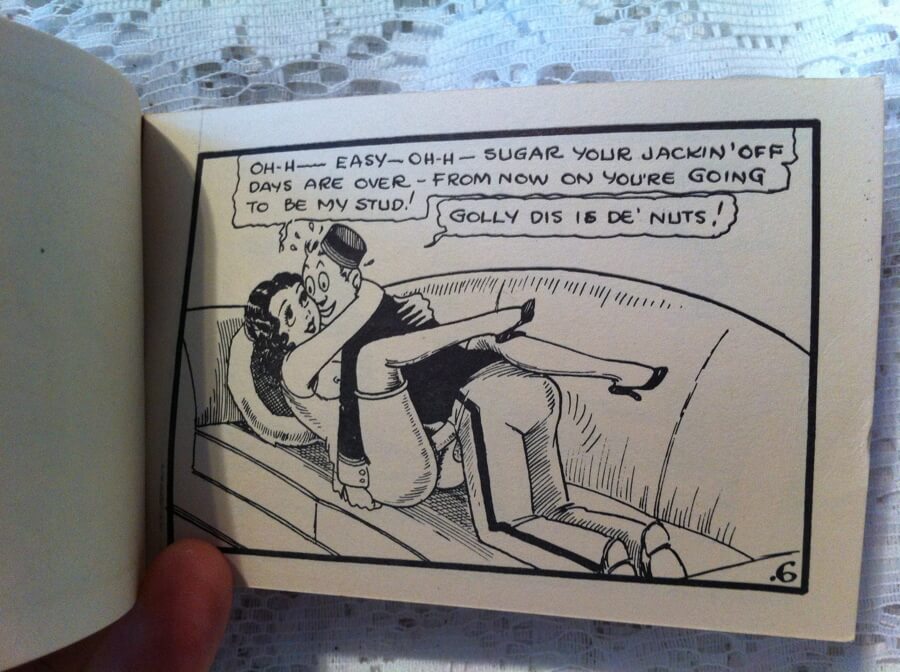
 Ginger Rogers in "Hot Panties", (n.p. n.d.) 4.5" x 3", 8pp. pamphlet, stapled Tijuana bibles (also known as eight-pagers, bluesies, gray-backs, Jiggs-and-Maggie books, jo-jo books, Tillie-and-Mac books, and two-by-fours) were little pornographic comic books produced in the United States from the 1920s to the early 1960s.
Ginger Rogers in "Hot Panties", (n.p. n.d.) 4.5" x 3", 8pp. pamphlet, stapled Tijuana bibles (also known as eight-pagers, bluesies, gray-backs, Jiggs-and-Maggie books, jo-jo books, Tillie-and-Mac books, and two-by-fours) were little pornographic comic books produced in the United States from the 1920s to the early 1960s. -
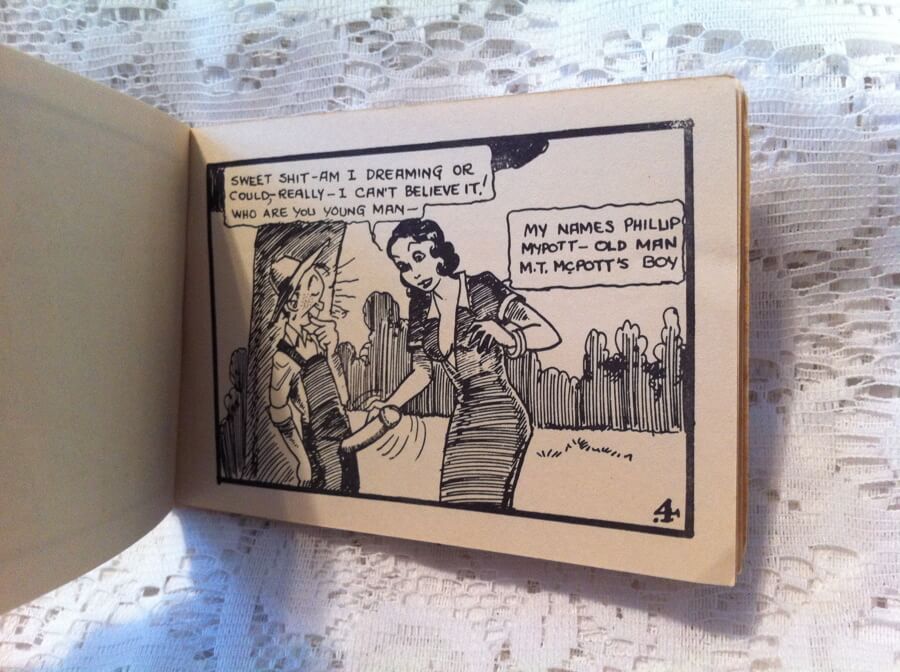
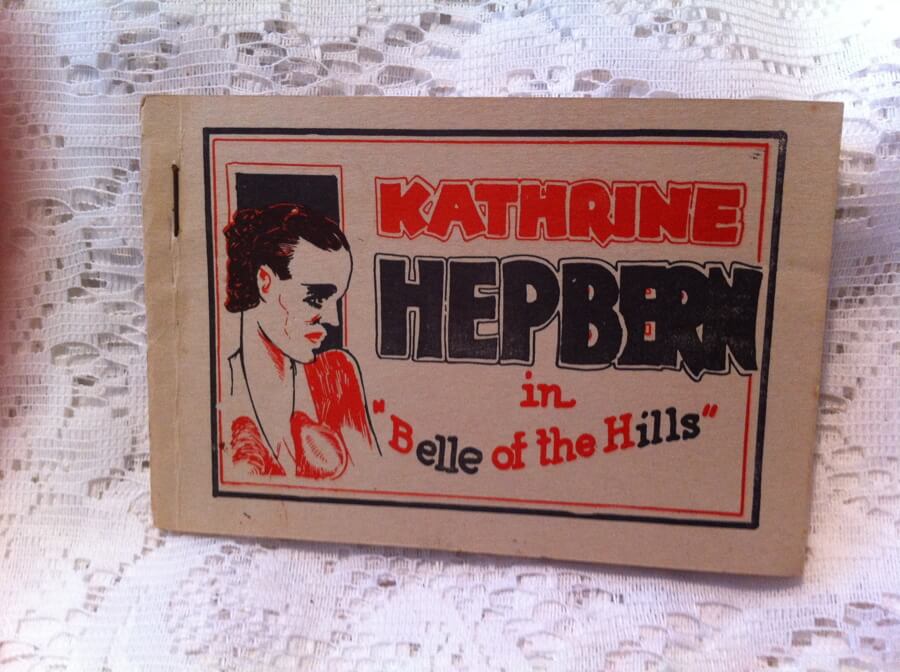 Katherine Hepbern in "Belle of the Hills", (n.p. n.d.) 4.5" x 3", 8pp. pamphlet, stapled Tijuana bibles (also known as eight-pagers, bluesies, gray-backs, Jiggs-and-Maggie books, jo-jo books, Tillie-and-Mac books, and two-by-fours) were little pornographic comic books produced in the United States from the 1920s to the early 1960s.
Katherine Hepbern in "Belle of the Hills", (n.p. n.d.) 4.5" x 3", 8pp. pamphlet, stapled Tijuana bibles (also known as eight-pagers, bluesies, gray-backs, Jiggs-and-Maggie books, jo-jo books, Tillie-and-Mac books, and two-by-fours) were little pornographic comic books produced in the United States from the 1920s to the early 1960s. -
Out of stock

 White Rebenque 23" long, flap is 12", white leather with rawhide/sinew stitching and decorations, slight yellowing from age. Beautiful hand-made white leather rebenque 50+ years old. It has decorative rawhide work on the handle and on the strap, using two colors of rawhide. The handle is textured by wrapping a wet cord around it, leaving an imprint on the leather. Rebenque is the name in Brazilian Portuguese for a type of whip used by gauchos in South America. Especially in Argentina, it is the traditional riding, fighting, and punishing whip of the gaucho. It consists of a rawhide wrapped wooden handle with a thong made of a leather strap a little longer than the handle. The wide strap made the rebenque an instrument less severe on the horse than the European riding crop. As the gaucho was never far from the horse, the rebenque was always on him. When not in use, he made a knot with the strap and held the rebenque lazily by the wrist strap with the middle fingers of his hand, or hung it from the handle of his facón knife (as he used the large knife almost horizontally at his back, held by the belt or waistband, the handle protruded from his right side). The rebenque was used also for fighting, as a weapon by itself, when the fight did not merit a knife, or with the strap rolled on his left hand and the handle hanging, as a secondary weapon to the knife in his right hand. Of course, it was also used for domestic punishments, and for quasi-judicial chastisement. A couple of lashes with the rebenque on the bare legs were widely used as a punishment for children, even in the urban areas.
White Rebenque 23" long, flap is 12", white leather with rawhide/sinew stitching and decorations, slight yellowing from age. Beautiful hand-made white leather rebenque 50+ years old. It has decorative rawhide work on the handle and on the strap, using two colors of rawhide. The handle is textured by wrapping a wet cord around it, leaving an imprint on the leather. Rebenque is the name in Brazilian Portuguese for a type of whip used by gauchos in South America. Especially in Argentina, it is the traditional riding, fighting, and punishing whip of the gaucho. It consists of a rawhide wrapped wooden handle with a thong made of a leather strap a little longer than the handle. The wide strap made the rebenque an instrument less severe on the horse than the European riding crop. As the gaucho was never far from the horse, the rebenque was always on him. When not in use, he made a knot with the strap and held the rebenque lazily by the wrist strap with the middle fingers of his hand, or hung it from the handle of his facón knife (as he used the large knife almost horizontally at his back, held by the belt or waistband, the handle protruded from his right side). The rebenque was used also for fighting, as a weapon by itself, when the fight did not merit a knife, or with the strap rolled on his left hand and the handle hanging, as a secondary weapon to the knife in his right hand. Of course, it was also used for domestic punishments, and for quasi-judicial chastisement. A couple of lashes with the rebenque on the bare legs were widely used as a punishment for children, even in the urban areas. -

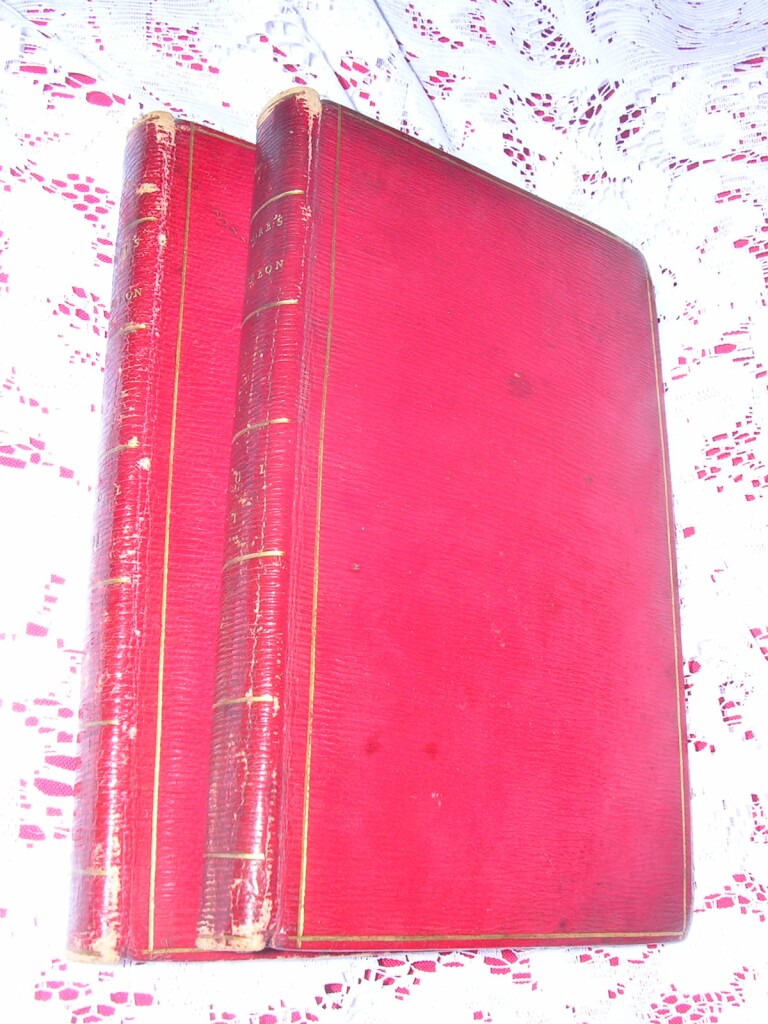 Odes of Anacreon, Anacreon, trans. Thomas Moore (J. and T. Carpenter, London, 1802) 6 1/2" X 4 1/4", 2 vol. 163pp 148pp, hardbound in red morocco with gilt lettering and decorations, gilted edges, marbled boards, worn edges and corners befitting it's age, binding tight, ribbon markers intact. Armorial bookplate of british judge, Geoffrey Lord Cross of Chelsea on front pastedowns Anacreon (582 BC _ 485 BC) was a Greek lyric poet, notable for his drinking songs and hymns. Later Greeks included him in the canonical list of nine lyric poets. Thomas Moore (1779 _ 1852) is considered Ireland's "National Bard". He was a poet, singer, songwriter, and entertainer. He was responsible, with John Murray, for burning Lord Byron's memoirs after his death. These books are the second edition (original edition published in 1800) of his first work, a translation that he did at Middle Temple where he studied law. In his lifetime he was often referred to as Anacreon Moore.
Odes of Anacreon, Anacreon, trans. Thomas Moore (J. and T. Carpenter, London, 1802) 6 1/2" X 4 1/4", 2 vol. 163pp 148pp, hardbound in red morocco with gilt lettering and decorations, gilted edges, marbled boards, worn edges and corners befitting it's age, binding tight, ribbon markers intact. Armorial bookplate of british judge, Geoffrey Lord Cross of Chelsea on front pastedowns Anacreon (582 BC _ 485 BC) was a Greek lyric poet, notable for his drinking songs and hymns. Later Greeks included him in the canonical list of nine lyric poets. Thomas Moore (1779 _ 1852) is considered Ireland's "National Bard". He was a poet, singer, songwriter, and entertainer. He was responsible, with John Murray, for burning Lord Byron's memoirs after his death. These books are the second edition (original edition published in 1800) of his first work, a translation that he did at Middle Temple where he studied law. In his lifetime he was often referred to as Anacreon Moore. -

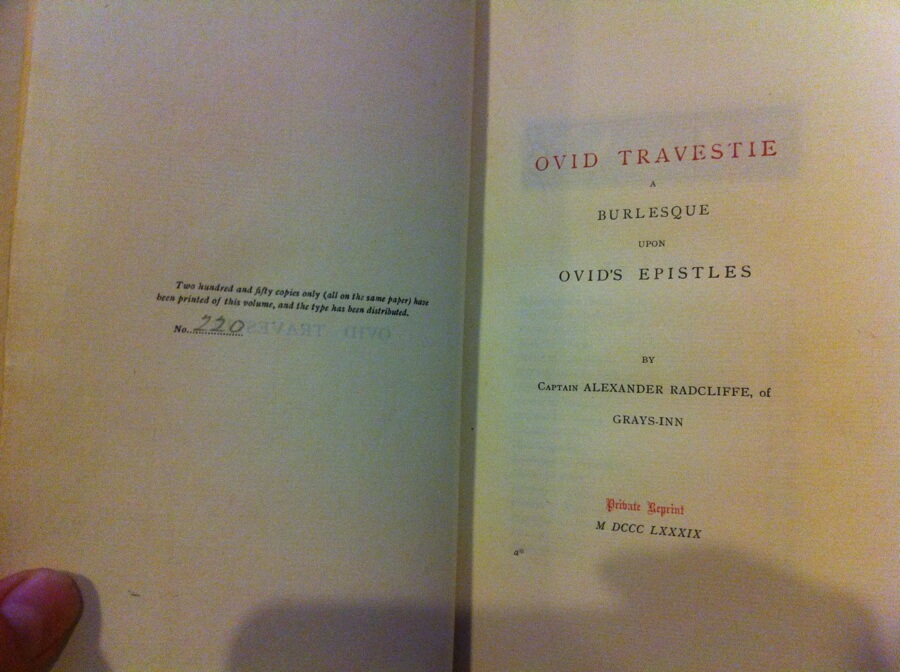 Ovid Travestie: A Burlesque upon Ovid's Epistles, Captain Alexander Radcliffe, of Grays-Inn (Private Reprint, 1889 [Smithers/Nichols Erotica Biblion Society?] #220/250) 8.75" X 5.5", 102pp, hardbound with plain black boards, pages untrimmed. Very good condition. Reprint of an obscene parody of Ovid, first published in 1680, with 17th-century English characters substituted for Ovid's Romans. 'That it merits a place in every collector's library is undisputed, its singularly easy strain of wit and ludicrous parody of Ovid's famed Heroides, shewing Capt. Radcliffe to possess not only an intimate knowledge of Ovid's manner, but a graphic power of turning to ridicule his author's most poetic flights.' So says the introduction, adding that nonetheless it 'is not a volume fitted for the ordinary bookshelf'. "The present reprint is made verbatim from the fourth and complete edition (A.D. 1705)." Alfred Rose (Registrum Librorum Eroticorum, entry no. 3380), lists an edition with the same date and limitation as the present edition, but with the impress of the Smithers/Nichols Erotica Biblion Society."
Ovid Travestie: A Burlesque upon Ovid's Epistles, Captain Alexander Radcliffe, of Grays-Inn (Private Reprint, 1889 [Smithers/Nichols Erotica Biblion Society?] #220/250) 8.75" X 5.5", 102pp, hardbound with plain black boards, pages untrimmed. Very good condition. Reprint of an obscene parody of Ovid, first published in 1680, with 17th-century English characters substituted for Ovid's Romans. 'That it merits a place in every collector's library is undisputed, its singularly easy strain of wit and ludicrous parody of Ovid's famed Heroides, shewing Capt. Radcliffe to possess not only an intimate knowledge of Ovid's manner, but a graphic power of turning to ridicule his author's most poetic flights.' So says the introduction, adding that nonetheless it 'is not a volume fitted for the ordinary bookshelf'. "The present reprint is made verbatim from the fourth and complete edition (A.D. 1705)." Alfred Rose (Registrum Librorum Eroticorum, entry no. 3380), lists an edition with the same date and limitation as the present edition, but with the impress of the Smithers/Nichols Erotica Biblion Society." -
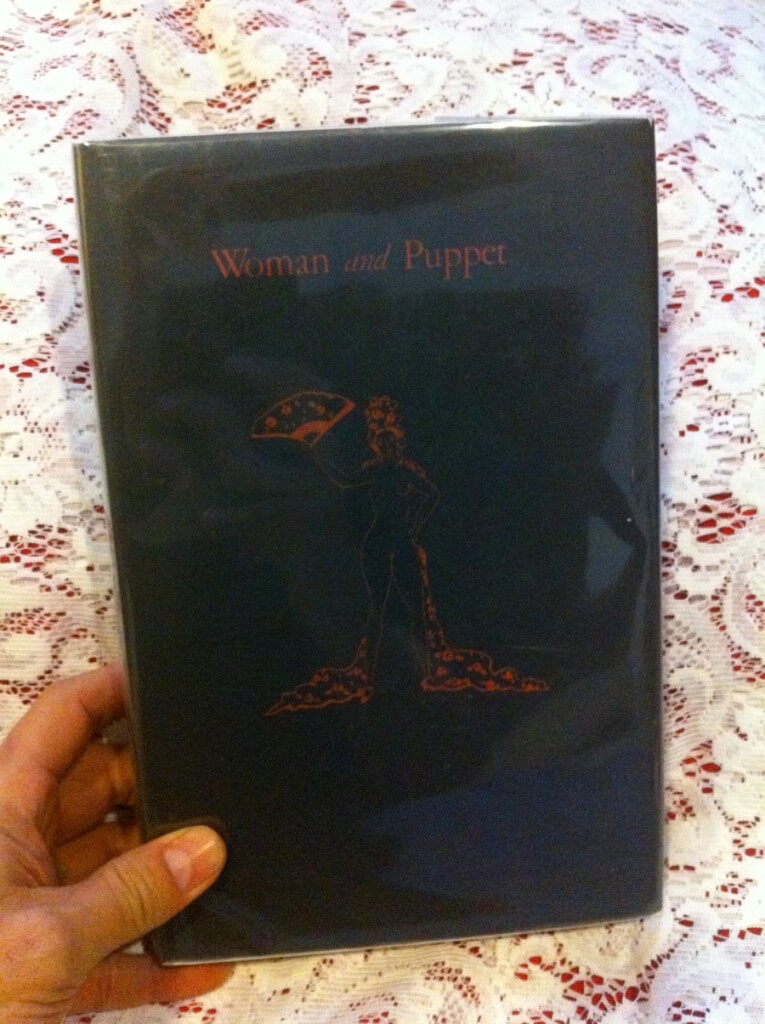
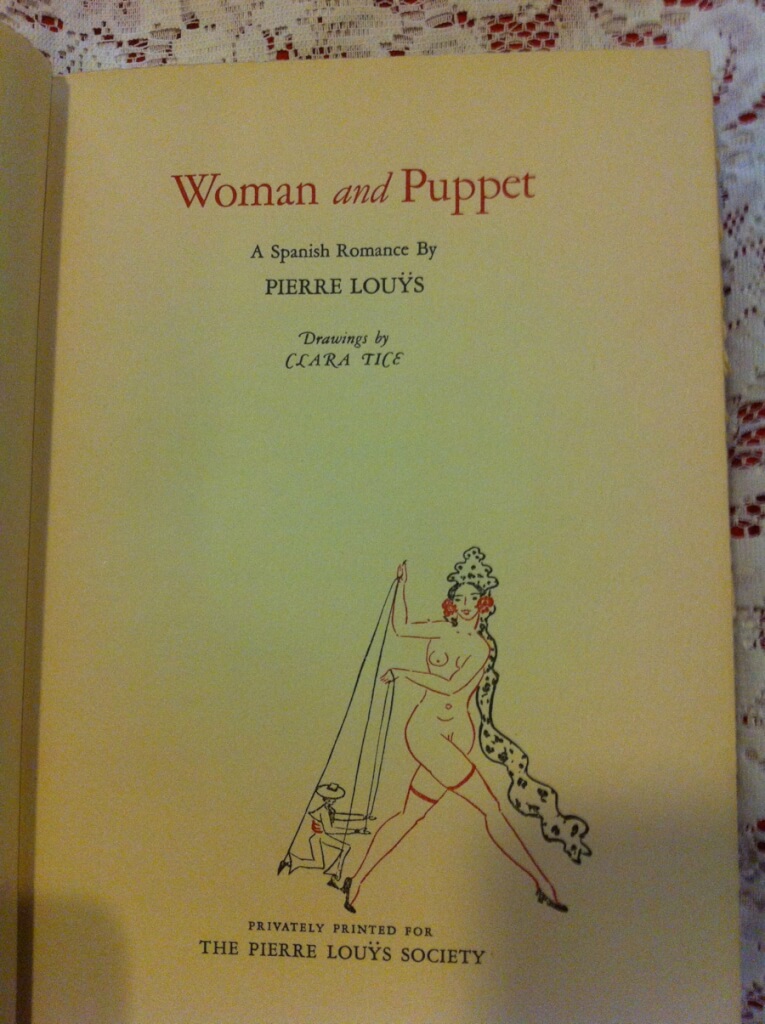 Woman and Puppet, Pierre Louys, illustrated by Clara Tice, "designed and supervised by Harry Cunningham" (The Pierre Louys Society, US, 1927, #617/990) 9 7/8" X 6 1/2", 270pp, hardbound with , black boards with red titles and decorations, MINT condition, with dust jacket wrapped in mylar. Bookstore stamp on front paste-down "C. J. Schnieder Books" During the carnival in Seville, the Frenchman André Stévenol meets and falls under the spell of Conception 'Concita' Perez, a young Andalusian woman. His friend, don Mateo Diaz warns him off by describing his own history with the woman – a history of being repeatedly attracted and then rebuffed by her. Conchita continually flirted with other men to torture don Mateo. On each occasion he was made to feel guilty for his jealous thoughts and actions towards her, until he realised finally that he had been her puppet for fourteen months and in an explosion of passion he beat her. She then astonished him by declaring the violence a sign of the strength of his love and came to his bed. She was a virgin. Although the two then started living together, she continued her flirtatious behaviour towards other men and simultaneously became very possessive. Don Mateo left the country and travelled for a year to escape her. The novel has a short epilogue, described as the moral of the piece. The Frenchman accidentally meets Conchita again, and they spend the night together. The next morning, as Conchita packs her bags for Paris, a note is received from don Mateo asking to be taken back into Conchita's good graces. Pierre Louys (1870 - 1925) was a French poet and writer, most renowned for lesbian and classical themes in some of his writings. He is known as a writer who "expressed pagan sensuality with stylistic perfection." Woman and Puppet is described as "Spanish romance". The "puppet" in the story refers to men she is able or unable to bend to her will.
Woman and Puppet, Pierre Louys, illustrated by Clara Tice, "designed and supervised by Harry Cunningham" (The Pierre Louys Society, US, 1927, #617/990) 9 7/8" X 6 1/2", 270pp, hardbound with , black boards with red titles and decorations, MINT condition, with dust jacket wrapped in mylar. Bookstore stamp on front paste-down "C. J. Schnieder Books" During the carnival in Seville, the Frenchman André Stévenol meets and falls under the spell of Conception 'Concita' Perez, a young Andalusian woman. His friend, don Mateo Diaz warns him off by describing his own history with the woman – a history of being repeatedly attracted and then rebuffed by her. Conchita continually flirted with other men to torture don Mateo. On each occasion he was made to feel guilty for his jealous thoughts and actions towards her, until he realised finally that he had been her puppet for fourteen months and in an explosion of passion he beat her. She then astonished him by declaring the violence a sign of the strength of his love and came to his bed. She was a virgin. Although the two then started living together, she continued her flirtatious behaviour towards other men and simultaneously became very possessive. Don Mateo left the country and travelled for a year to escape her. The novel has a short epilogue, described as the moral of the piece. The Frenchman accidentally meets Conchita again, and they spend the night together. The next morning, as Conchita packs her bags for Paris, a note is received from don Mateo asking to be taken back into Conchita's good graces. Pierre Louys (1870 - 1925) was a French poet and writer, most renowned for lesbian and classical themes in some of his writings. He is known as a writer who "expressed pagan sensuality with stylistic perfection." Woman and Puppet is described as "Spanish romance". The "puppet" in the story refers to men she is able or unable to bend to her will. -

 Jakub Casanova: Memoiry (Czech: Cassanova's Memoirs), Giacomo Casanova (Alois Hynek, J. Rokyta, Praze, n.d. [c. 1890-1900]) 8.75" X 6.25" 9 vol. in 8 books 275pp. [220pp 144pp in one vol.] 283pp. 358pp. 304pp. 356pp. 326pp. 345 i-v. Hardcover with beautifully decorated red cloth boards. Very good condition. Rare complete set with full color boards. Even more rare copy translated into Czech. Giovanni Giacomo Casanova (1725-1798) was an ecclesiastic, writer, soldier, spy, and diplomatist, chiefly remembered as the prince of Italian adventurers and as the man who made the name Casanova synonymous with "libertine." His autobiography, which perhaps exaggerates some of his escapades, is a splendid description of 18th-century society in the capitals of Europe. This is a beautiful Czech edition, 9 volumes in 8 books in publisher's original decorative cloth-binding. A beautifully bound edition. I am unable to find another complete set. The only other place I can find mention these books is in the Czech National Library.
Jakub Casanova: Memoiry (Czech: Cassanova's Memoirs), Giacomo Casanova (Alois Hynek, J. Rokyta, Praze, n.d. [c. 1890-1900]) 8.75" X 6.25" 9 vol. in 8 books 275pp. [220pp 144pp in one vol.] 283pp. 358pp. 304pp. 356pp. 326pp. 345 i-v. Hardcover with beautifully decorated red cloth boards. Very good condition. Rare complete set with full color boards. Even more rare copy translated into Czech. Giovanni Giacomo Casanova (1725-1798) was an ecclesiastic, writer, soldier, spy, and diplomatist, chiefly remembered as the prince of Italian adventurers and as the man who made the name Casanova synonymous with "libertine." His autobiography, which perhaps exaggerates some of his escapades, is a splendid description of 18th-century society in the capitals of Europe. This is a beautiful Czech edition, 9 volumes in 8 books in publisher's original decorative cloth-binding. A beautifully bound edition. I am unable to find another complete set. The only other place I can find mention these books is in the Czech National Library. -
 La Génération de l' Homme ou Tableau de l' Amour Conjugal, considéré dans l'état du mariage, Nicolas Venette (np London, 1768, "Nouvelle Édition") 6.25″x3.75″, 408pp, vol. 1 only (of 2), full mottled calf, 5 raised bands worn), gilt title and decorations on spine (worn), marbled boards, fair condition for age, beautiful illustrations including a beautifully engraved frontispiece and title page. Nicolas Venette (1633–1698) was a physician, sexologist and French writer. Born in La Rochelle, he studied medicine at Bordeaux where he received his doctorate in 1656. He then went to Paris where he studied under Guy Patin and Pierre Petit, before travelling to Spain, Portugal and Italy. He then returned to La Rochelle, where he became Regius Professor of Anatomy and Surgery in 1668. First published in Amsterdam in 1686 as Tableau de l’amour humain considéré dans l’état du mariage (Table of human love considered in the state of marriage) under the pseudonym Salocini Venetian (anagram of Nicolas Venette), this book, more properly titled Table of conjugal love, or the complete history of the generation of man, is considered to be the first treatise on sexology in West. It proved to be a bestseller and was translated into English, Spanish, German and Dutch. There were 33 editions published sporadically until 1903. This edition was published in 1768 in two-volume. This book is volume 1. The author discusses four sub-topics with respect to sex: anatomy, reproduction, desire, and impotence/infertility. For each topic, he reviews ancient and medieval authors, adding his own observations or those of later authors, and comments where common sense prevails. The resulting composition has an ambiguous mixture of seriousness and light-heartedness bordering upon erotic literature.
La Génération de l' Homme ou Tableau de l' Amour Conjugal, considéré dans l'état du mariage, Nicolas Venette (np London, 1768, "Nouvelle Édition") 6.25″x3.75″, 408pp, vol. 1 only (of 2), full mottled calf, 5 raised bands worn), gilt title and decorations on spine (worn), marbled boards, fair condition for age, beautiful illustrations including a beautifully engraved frontispiece and title page. Nicolas Venette (1633–1698) was a physician, sexologist and French writer. Born in La Rochelle, he studied medicine at Bordeaux where he received his doctorate in 1656. He then went to Paris where he studied under Guy Patin and Pierre Petit, before travelling to Spain, Portugal and Italy. He then returned to La Rochelle, where he became Regius Professor of Anatomy and Surgery in 1668. First published in Amsterdam in 1686 as Tableau de l’amour humain considéré dans l’état du mariage (Table of human love considered in the state of marriage) under the pseudonym Salocini Venetian (anagram of Nicolas Venette), this book, more properly titled Table of conjugal love, or the complete history of the generation of man, is considered to be the first treatise on sexology in West. It proved to be a bestseller and was translated into English, Spanish, German and Dutch. There were 33 editions published sporadically until 1903. This edition was published in 1768 in two-volume. This book is volume 1. The author discusses four sub-topics with respect to sex: anatomy, reproduction, desire, and impotence/infertility. For each topic, he reviews ancient and medieval authors, adding his own observations or those of later authors, and comments where common sense prevails. The resulting composition has an ambiguous mixture of seriousness and light-heartedness bordering upon erotic literature. -
 La Génération de l' Homme ou Tableau de l' Amour Conjugal, considéré dans l'état du mariage, tome premier, Nicolas Venette (np 1776) 4″x6.75″, 365pp, vol. 1 only (of 2), full mottled calf, 5 raised bands, titles on spine are worn off, marbled boards loose but holding, fair condition for age. Illustrated throughout including a beautifully engraved frontispiece and title page, some illustrations are fold-outs. Nicolas Venette (1633–1698) was a physician, sexologist and French writer. Born in La Rochelle, he studied medicine at Bordeaux where he received his doctorate in 1656. He then went to Paris where he studied under Guy Patin and Pierre Petit, before travelling to Spain, Portugal and Italy. He then returned to La Rochelle, where he became Regius Professor of Anatomy and Surgery in 1668. First published in Amsterdam in 1686 as Tableau de l’amour humain considéré dans l’état du mariage (Table of human love considered in the state of marriage) under the pseudonym Salocini Venetian (anagram of Nicolas Venette), this book, more properly titled Table of conjugal love, or the complete history of the generation of man, is considered to be the first treatise on sexology in West. It proved to be a bestseller and was translated into English, Spanish, German and Dutch. There were 33 editions published sporadically until 1903. This edition was published in 1776 in two-volume. This book is volume 1. Many images are upgraded from previous editions to be fold-outs. The author discusses four sub-topics with respect to sex: anatomy, reproduction, desire, and impotence/infertility. For each topic, he reviews ancient and medieval authors, adding his own observations or those of later authors, and comments where common sense prevails. The resulting composition has an ambiguous mixture of seriousness and light-heartedness bordering upon erotic literature.
La Génération de l' Homme ou Tableau de l' Amour Conjugal, considéré dans l'état du mariage, tome premier, Nicolas Venette (np 1776) 4″x6.75″, 365pp, vol. 1 only (of 2), full mottled calf, 5 raised bands, titles on spine are worn off, marbled boards loose but holding, fair condition for age. Illustrated throughout including a beautifully engraved frontispiece and title page, some illustrations are fold-outs. Nicolas Venette (1633–1698) was a physician, sexologist and French writer. Born in La Rochelle, he studied medicine at Bordeaux where he received his doctorate in 1656. He then went to Paris where he studied under Guy Patin and Pierre Petit, before travelling to Spain, Portugal and Italy. He then returned to La Rochelle, where he became Regius Professor of Anatomy and Surgery in 1668. First published in Amsterdam in 1686 as Tableau de l’amour humain considéré dans l’état du mariage (Table of human love considered in the state of marriage) under the pseudonym Salocini Venetian (anagram of Nicolas Venette), this book, more properly titled Table of conjugal love, or the complete history of the generation of man, is considered to be the first treatise on sexology in West. It proved to be a bestseller and was translated into English, Spanish, German and Dutch. There were 33 editions published sporadically until 1903. This edition was published in 1776 in two-volume. This book is volume 1. Many images are upgraded from previous editions to be fold-outs. The author discusses four sub-topics with respect to sex: anatomy, reproduction, desire, and impotence/infertility. For each topic, he reviews ancient and medieval authors, adding his own observations or those of later authors, and comments where common sense prevails. The resulting composition has an ambiguous mixture of seriousness and light-heartedness bordering upon erotic literature. -

 (2 x 2") + (2 3/4 x 3 1/4") Shackles (matched pair ankle/wrist) Antique hand-forged iron shackles from a farm in Bulgaria. They have been cleaned up and seasoned much like you'd season your cast iron skillet (repeatedly coated with oil and baked). No key is needed as they lock using a puzzle design.
(2 x 2") + (2 3/4 x 3 1/4") Shackles (matched pair ankle/wrist) Antique hand-forged iron shackles from a farm in Bulgaria. They have been cleaned up and seasoned much like you'd season your cast iron skillet (repeatedly coated with oil and baked). No key is needed as they lock using a puzzle design. -
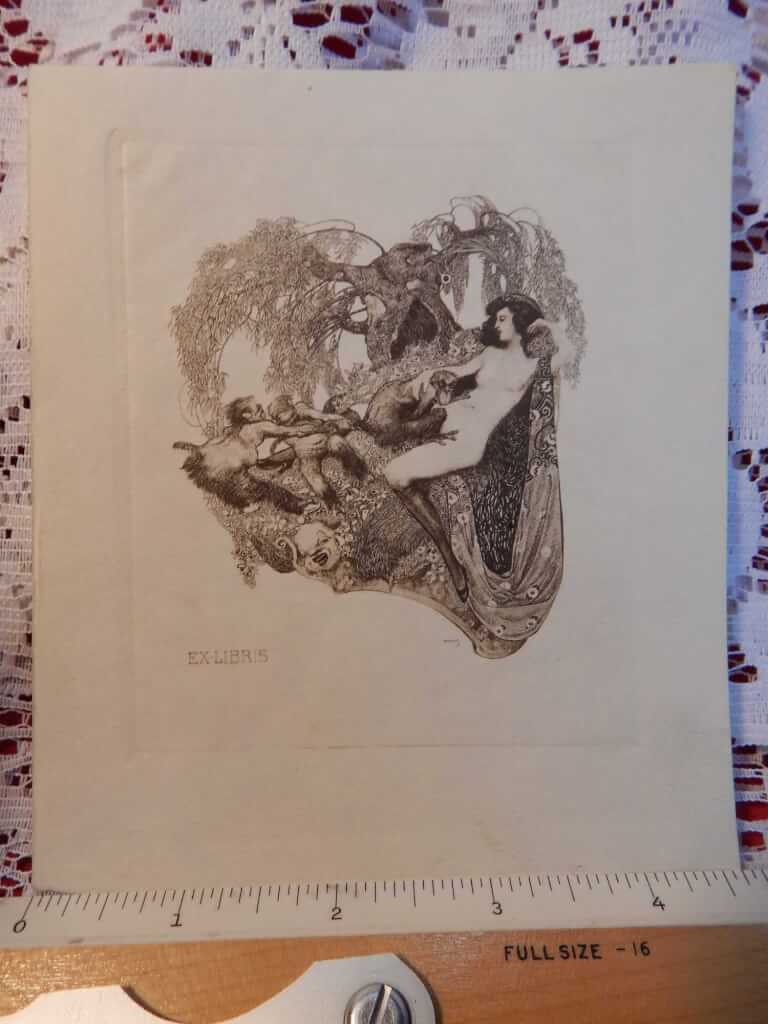 Ex Libris, by Franz von Bayros paper size 4.75 x 5.5", print size 3.5 x 4" naked woman sitting in a tree being "intimate" with monkey, other monkeys trying to pull him away from her. Very detailed and ornate. Franz von Bayros (1866 – 1924) was an Austrian commercial artist, illustrator, and painter, now he is best known for his erotic work. He belonged to the Decadent movement in art, often utilizing erotic themes and phantasmagoric imagery. At the age 17, Bayros passed the entrance exam for the Vienna Academy with Eduard von Engerth. Bayros mixed in elegant society and soon belonged to the circle of friends of Johann Straub, whose step daughter Alice he married on 1896. The next year, Bayros moved to Munich. In 1904, Bayros gave his first exhibition in Munich, which was a great success. From 1904 until 1908, Bayros traveled to Paris and Italy for his studies. Typically, for an artist dealing with such imagery, von Bayros produced work under several pseudonyms, most notably Choisy Le Conin, and was hounded by authorities for much of his life for his “indecent” art often very imaginative, and including such taboo subjects as sadomasochism and bestiality. He became equally well-known for his masterly drawn figures of elegant modestly nude and non-nude women.
Ex Libris, by Franz von Bayros paper size 4.75 x 5.5", print size 3.5 x 4" naked woman sitting in a tree being "intimate" with monkey, other monkeys trying to pull him away from her. Very detailed and ornate. Franz von Bayros (1866 – 1924) was an Austrian commercial artist, illustrator, and painter, now he is best known for his erotic work. He belonged to the Decadent movement in art, often utilizing erotic themes and phantasmagoric imagery. At the age 17, Bayros passed the entrance exam for the Vienna Academy with Eduard von Engerth. Bayros mixed in elegant society and soon belonged to the circle of friends of Johann Straub, whose step daughter Alice he married on 1896. The next year, Bayros moved to Munich. In 1904, Bayros gave his first exhibition in Munich, which was a great success. From 1904 until 1908, Bayros traveled to Paris and Italy for his studies. Typically, for an artist dealing with such imagery, von Bayros produced work under several pseudonyms, most notably Choisy Le Conin, and was hounded by authorities for much of his life for his “indecent” art often very imaginative, and including such taboo subjects as sadomasochism and bestiality. He became equally well-known for his masterly drawn figures of elegant modestly nude and non-nude women. -
 Memoirs of Cardinal Dubois | translated from the French by Ernest Dowson | with photogravure portraits of Cardinal Dubois and the Duc d'Orleans (Leonard Smithers and Co, London, 1899, First Edition thus, first English translation) 9.75"x6.5", 2 volumes, xvi-282pp, viii-268pp, blue boards with gilt decoration and titles on spine, deckled edges, good condition, bumping to corners, bookplates for Reginald Dalton Pontifex in both volumes. According to the publisher, the original manuscript which was written entirely in Dubois hand was stolen by his secretary Lavergne after his death in 1723. It was later discovered of its literary value that Lavergne attempted to sell the manuscript. He was found and arrested. They later fell into the hands of Comte de Maurepas, then upon his death they were passed on to an anonymous writer named Mercier (possibly M. Paul Laroix) whose family had it published in 1829. The manuscript then became lost. In 1899 and English version of the book translated by Ernest Christopher Dowson, was published by the notorious pornographer, Leonard Smithers & Co. This is, presumably a reprinting of that translation. Guillaume Dubois (1656-1723), a son of a country doctor, rose from humble beginnings to positions of power and high honor in government and in the Catholic Church. He is best known for negotiating the Triple Alliance of 1717 between France, the Dutch Republic and Great Britain against their mutual enemy, Spain. Considered one of the four great French Cardinal-Ministers (Richelieu, Mazarin, Dubois, and Fleury). His ecclesiastical career left a great deal to be desired. Although there is no proof of the prevalent assertion that he got secretly married, his licentiousness, and notorious impiety, even at the time of his death, make it evident that he pursued and used ecclesiastical dignities principally to enhance his political position and prestige. Eventually in 1721, Du Bois was created cardinal. He had the reputation of a libertine and adventurer and made plenty of enemies. One of his rivals was charged at creating his portrait, the Duc de Saint-Simon, who was said to have placed a painting of Dubois in his lavatory. Saint-Simon had this to say about the Cardinal: "He was a little, pitiful, wizened, herring-gutted man, in a flaxen wig, with a weasel's face, brightened by some intellect. All the vices - perfidy, avarice, debauchery, ambition, flattery - fought within him for the mastery. He was so consummate a liar that, when taken in the fact, he could brazenly deny it. Even his wit and knowledge of the world were spoiled, and his affected gaiety was touched with sadness, by the odour of falsehood which escaped through every pore of his body." This famous picture is certainly biased. Dubois was unscrupulous, but so were his contemporaries, and whatever vices he had, he forged a European peace that, with the exception of small, restrained military expeditions against the Austrian Habsburgs, would last for a quarter of a century. Leonard Smithers (1861-1907), a solicitor born in Sheffield, was one of the most notable publishers of erotica of his day. He was said to be a brilliant but shady character who operated on the fringes of the rare book trade, issuing small, clandestine editions of risqué books with the boast: 'I will publish the things the others are afraid to touch'. He was notorious for posting a slogan at his bookshop in Bond Street reading "Smut is cheap today". He developed a friendship with Sir Richard Francis Burton and published Burton's famous translation of the Book of One Thousand and One Nights in 1885. He also worked with, among others, Aubrey Beardsley, Aleister Crowley, and Oscar Wilde. With Beardsley and Arthur Symons, he founded The Savoy, a periodical which ran for eight issues in 1896. Smithers famously partnered with Harry Nichols to publish a series of pornographic books under the Erotika Biblion Society imprint. When Beardsley, on his death bed, converted to Catholicism and asked Smithers to “destroy all copies of Lysistrata and bad drawings...by all that is holy all obscene drawings.", Smithers, famously and thankfully ignored him and continued to publish his works until his death in 1907. It was Smithers who published Oscar Wilde's The Ballad of Reading Gaol, a long poem commemorating the harsh rhythms of prison life in 1898. Smithers went bankrupt in 1900 and died impoverished in 1907 from cirrhosis of the liver. Up until his death he continued to sell reproductions (and forgeries) of Beardsley's work as well as reproductions of the Beardsley's letter asking him to destroy his drawings. Reginald Dalton Pontifex (1857–1951) was born in France, attended Magdalen College at Oxford from 1876–80, getting a Fourth in Law in 1880 and a Third in his BCL in 1882. He later practiced as a barrister. At the time of his death it was said he had quite the book collection containing, several of antiquarian interest. He bequethed his book collection to his alma mater. Most of his books were printed in the early nineteenth century and many of them extensively illustrated. He died in Bournemouth, Hampshire, England in 1951.
Memoirs of Cardinal Dubois | translated from the French by Ernest Dowson | with photogravure portraits of Cardinal Dubois and the Duc d'Orleans (Leonard Smithers and Co, London, 1899, First Edition thus, first English translation) 9.75"x6.5", 2 volumes, xvi-282pp, viii-268pp, blue boards with gilt decoration and titles on spine, deckled edges, good condition, bumping to corners, bookplates for Reginald Dalton Pontifex in both volumes. According to the publisher, the original manuscript which was written entirely in Dubois hand was stolen by his secretary Lavergne after his death in 1723. It was later discovered of its literary value that Lavergne attempted to sell the manuscript. He was found and arrested. They later fell into the hands of Comte de Maurepas, then upon his death they were passed on to an anonymous writer named Mercier (possibly M. Paul Laroix) whose family had it published in 1829. The manuscript then became lost. In 1899 and English version of the book translated by Ernest Christopher Dowson, was published by the notorious pornographer, Leonard Smithers & Co. This is, presumably a reprinting of that translation. Guillaume Dubois (1656-1723), a son of a country doctor, rose from humble beginnings to positions of power and high honor in government and in the Catholic Church. He is best known for negotiating the Triple Alliance of 1717 between France, the Dutch Republic and Great Britain against their mutual enemy, Spain. Considered one of the four great French Cardinal-Ministers (Richelieu, Mazarin, Dubois, and Fleury). His ecclesiastical career left a great deal to be desired. Although there is no proof of the prevalent assertion that he got secretly married, his licentiousness, and notorious impiety, even at the time of his death, make it evident that he pursued and used ecclesiastical dignities principally to enhance his political position and prestige. Eventually in 1721, Du Bois was created cardinal. He had the reputation of a libertine and adventurer and made plenty of enemies. One of his rivals was charged at creating his portrait, the Duc de Saint-Simon, who was said to have placed a painting of Dubois in his lavatory. Saint-Simon had this to say about the Cardinal: "He was a little, pitiful, wizened, herring-gutted man, in a flaxen wig, with a weasel's face, brightened by some intellect. All the vices - perfidy, avarice, debauchery, ambition, flattery - fought within him for the mastery. He was so consummate a liar that, when taken in the fact, he could brazenly deny it. Even his wit and knowledge of the world were spoiled, and his affected gaiety was touched with sadness, by the odour of falsehood which escaped through every pore of his body." This famous picture is certainly biased. Dubois was unscrupulous, but so were his contemporaries, and whatever vices he had, he forged a European peace that, with the exception of small, restrained military expeditions against the Austrian Habsburgs, would last for a quarter of a century. Leonard Smithers (1861-1907), a solicitor born in Sheffield, was one of the most notable publishers of erotica of his day. He was said to be a brilliant but shady character who operated on the fringes of the rare book trade, issuing small, clandestine editions of risqué books with the boast: 'I will publish the things the others are afraid to touch'. He was notorious for posting a slogan at his bookshop in Bond Street reading "Smut is cheap today". He developed a friendship with Sir Richard Francis Burton and published Burton's famous translation of the Book of One Thousand and One Nights in 1885. He also worked with, among others, Aubrey Beardsley, Aleister Crowley, and Oscar Wilde. With Beardsley and Arthur Symons, he founded The Savoy, a periodical which ran for eight issues in 1896. Smithers famously partnered with Harry Nichols to publish a series of pornographic books under the Erotika Biblion Society imprint. When Beardsley, on his death bed, converted to Catholicism and asked Smithers to “destroy all copies of Lysistrata and bad drawings...by all that is holy all obscene drawings.", Smithers, famously and thankfully ignored him and continued to publish his works until his death in 1907. It was Smithers who published Oscar Wilde's The Ballad of Reading Gaol, a long poem commemorating the harsh rhythms of prison life in 1898. Smithers went bankrupt in 1900 and died impoverished in 1907 from cirrhosis of the liver. Up until his death he continued to sell reproductions (and forgeries) of Beardsley's work as well as reproductions of the Beardsley's letter asking him to destroy his drawings. Reginald Dalton Pontifex (1857–1951) was born in France, attended Magdalen College at Oxford from 1876–80, getting a Fourth in Law in 1880 and a Third in his BCL in 1882. He later practiced as a barrister. At the time of his death it was said he had quite the book collection containing, several of antiquarian interest. He bequethed his book collection to his alma mater. Most of his books were printed in the early nineteenth century and many of them extensively illustrated. He died in Bournemouth, Hampshire, England in 1951. -

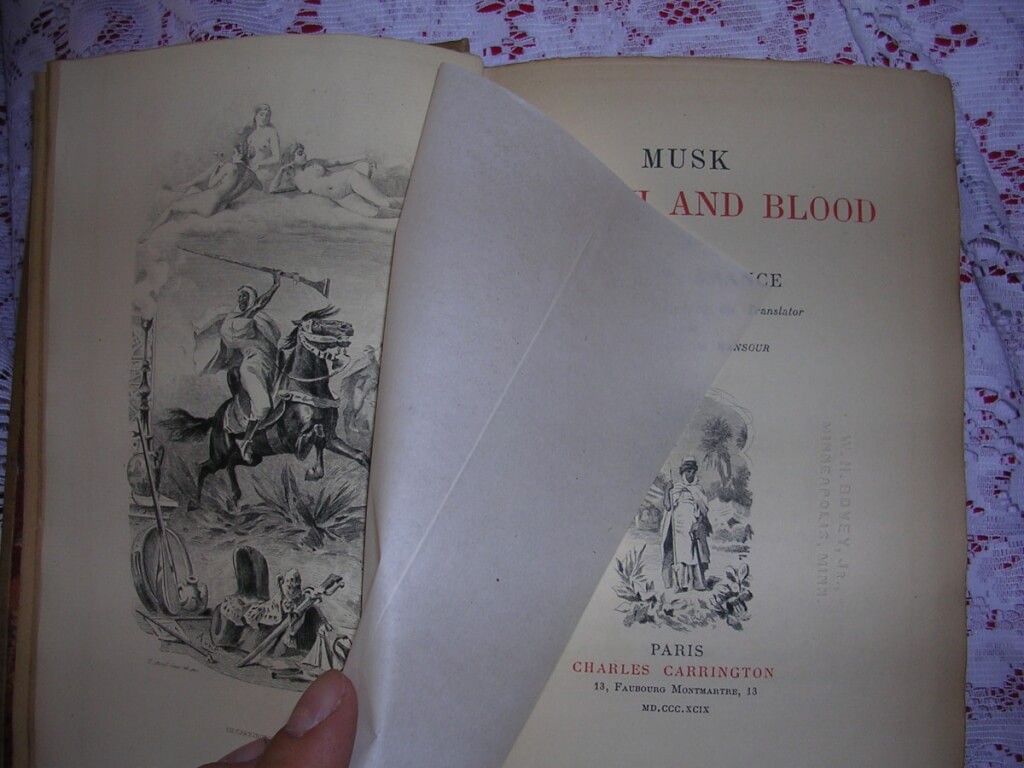 Musk, Hashish and Blood, Hector France, illust. Paul Avril, [trans. most likely Alfred Richard Allinson] (Charles Carrington, Paris, 1899) 8.5" X 5.5", xiii 447pp., hardbound, cloth boards with gilt tittles and decorations. Marbled end papers, deckled edges, frontispiece with tissue guard and numerous illustrations throughout. Good condition, binding is cocked but intact. Owner's signature in front, ink stamp in back, and imprint on title page reads "W.H. Bovey, Minneapolis, MN." Hector France (1837 - 1908) was a French author best known for his "orientalist" and flagellation tales. This graphic and exciting picture of the Algerian desert, its tribes and their astounding customs is a sensational recounting of France's experiences in North Africa. France tells the stories of his adventures in the nineteenth century Arab world from an eyewitness view. "The adventures of a modern man among the cruel men and passionate women of Algiers." Édouard-Henri Avril (1849-1928) used the pseudonym "Paul Avril" for his erotic work. He was a French painter and commercial artist. His career saw collaboration with influential people like Octave Uzanne, Henry Spencer Ashbee and Friedrich Karl Forberg. He is one of the most celebrated erotic artists of his age. Avril was a soldier before starting his career in art. He was awarded with the Legion of Honour for his actions in the Franco-Prussian War.
Musk, Hashish and Blood, Hector France, illust. Paul Avril, [trans. most likely Alfred Richard Allinson] (Charles Carrington, Paris, 1899) 8.5" X 5.5", xiii 447pp., hardbound, cloth boards with gilt tittles and decorations. Marbled end papers, deckled edges, frontispiece with tissue guard and numerous illustrations throughout. Good condition, binding is cocked but intact. Owner's signature in front, ink stamp in back, and imprint on title page reads "W.H. Bovey, Minneapolis, MN." Hector France (1837 - 1908) was a French author best known for his "orientalist" and flagellation tales. This graphic and exciting picture of the Algerian desert, its tribes and their astounding customs is a sensational recounting of France's experiences in North Africa. France tells the stories of his adventures in the nineteenth century Arab world from an eyewitness view. "The adventures of a modern man among the cruel men and passionate women of Algiers." Édouard-Henri Avril (1849-1928) used the pseudonym "Paul Avril" for his erotic work. He was a French painter and commercial artist. His career saw collaboration with influential people like Octave Uzanne, Henry Spencer Ashbee and Friedrich Karl Forberg. He is one of the most celebrated erotic artists of his age. Avril was a soldier before starting his career in art. He was awarded with the Legion of Honour for his actions in the Franco-Prussian War.












